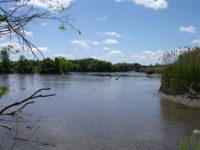Hydropower sector participants that traditionally have been at odds–industry firms, dam safety groups, and environmental advocates—are working together on a shared new mission—to push legislation and projects to upgrade the growing fleet of deteriorating dams across the country and remove those structures that serve no economic purpose.
A diverse coalition of dam-focused entities that includes the American Society of Civil Engineers, The World Wildlife Fund and the Association of State Dam Safety Officials was able to secure more than $800 million for hydropower and pumped-storage investments, as well as funds to improve dam safety, in the recently enacted Infrastructure Investment and Jobs Act.
They now advocate inclusion of a 30% tax credit for hydroelectric dams, among other dam-related provisions, in the Build Back Better Act. Although the $1.7 trillion social and spending bill has been stalled in the U.S. Senate for months, lawmakers from both parties have recently signaled their support for carving out and bringing to a vote some of its non-controversial provisions, including the climate- and energy-related measures.
The groups have been meeting for more than two years through the Stanford Woods Institute for the Environment’s “Uncommon Dialogues” initiative, which seeks to bring groups often on opposite sides of hot-button issues into one room to find areas of agreement. Institute Director Chris Field says the groups are encouraged to work in a non-confrontational way to “probe for possible solutions” that might have previously seemed intractable.
One early program success was passage in 2014 of the Sustainable Groundwater Management Act in California, which Field says was made possible largely through the collaboration of farmers, irrigation districts and conservation organizations that came together through the Uncommon Dialogues initiative.
While some participants may have had different political ideologies, “everybody was interested in a similar set of outcomes, with a management framework in place where groundwater resources were tracked,” Field says. Dan Reicher, a senior research scholar at Stanford and a former US Energy Dept. assistant secretary, has chaired the hydropower group.
LeRoy Coleman, a spokesman for the National Hydropower Association, says the groups came together because of the deteriorating conditions of dam infrastructure in the U.S. as well a general consensus that hydroelectric power could be a useful tool in addressing climate change. “I think the fact that hydro was included in the Build Back Better package demonstrates that Congress recognizes that it is critical to a clean energy future,” he says. Of the more than 90,000 dams in the U.S., only 2,500 are equipped to generate hydroelectric power. “So there’s an opportunity there.”
But many of those 90,000 dams are in poor condition. According to ASCE, by 2030, seven out of 10 dams in the U.S. will be more than 50 years old, many not built to current standards or designed with climate change resilience in mind. Because the federal relicensing process can take more than seven years to complete, many dam owners are considering decommissioning facilities, the hydropower association says.
The groups continue to meet and are working on new legislation to propose in February.
Brian Graber, senior director of American Rivers’ river restoration program, says that he isn’t sure that any of the groups would have been as successful on their own in persuading lawmakers to include so much funding for dams, dam removals and dam safety. Support for the hydroelectric provisions was largely bipartisan, he says. Some dam safety and environmental provisions in the infrastructure law were championed by Senate Republican Rob Portman (Ohio). “It’s unusual for Republican senators to support environmental provisions,” Graber says, but because the groups worked together, they were able to propose the measures that they could agree on as a “full package.”
While the groups work together when they can, there are still areas of disagreement, Graber says. American Rivers is supportive of upgrades and retrofits, but not necessarily of building new dams.
“Very simply, we want to make sure that the environmental provisions remain in hydropower…and for dams that don’t have a significant use, prepare them for removal,” he says.






